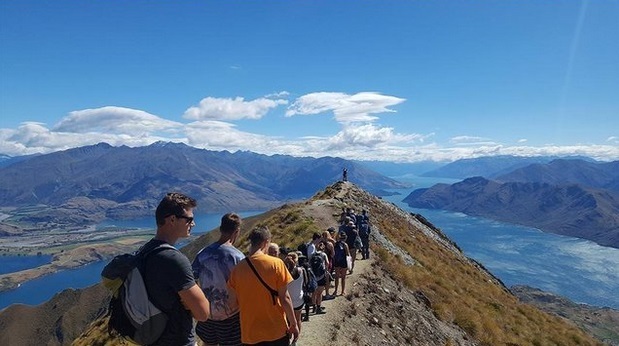Kiwis enjoy uncongested local tracks
Zella Downing
11 January 2021, 5:04 PM
 There were 67 per cent fewer walkers on Mt Iron than usual during spring. PHOTO: Wanaka App
There were 67 per cent fewer walkers on Mt Iron than usual during spring. PHOTO: Wanaka AppFewer visitor numbers are being reflected in lower numbers of people using local tracks - and lower numbers needing to be rescued.
Wanaka saw a decline in visitor numbers over spring, reflecting the drop in international visitors.
Visitor activity counter data on Department of Conservation (DOC) tracks near Wanaka for September/October 2020, when compared to the previous year, shows numbers on Roys Peak Track and Ben Lomond track were down 42 per cent and 31 per cent respectively, and the Mt Iron Track was down a whopping 67 per cent.
"There have been reduced visitor numbers in the Upper Clutha area of Central Otago District, where international visitor numbers have in the past been steady throughout the summer season, but it’s been fantastic to see so many New Zealanders getting out in the stunning mountains, lakes and forests around Central Otago," DOC Central Otago District senior ranger Nicole Sutton said.
In other parts of Central Otago, such as the Otago Central Rail Trail, domestic visitors have always been the predominant users, and visitor activity was up 55 per cent.

There have been no scenes like this on Roys Peak this summer. PHOTO: Lukas
The summer season has also been "particularly quiet" so far for Wanaka Search and Rescue (SAR).
Chairperson Aaron Nicholson said while normally SAR is quite busy at this time of year - at times with as many as three jobs in one day - so far this year the volunteer group has had only three or four jobs across the past three months.
Those rescues were considered minor, Aaron said, adding that the usual number of rescues over summer would be in double figures by now.
People with time up their sleeves are in a position to plan their trips better, he suggested.
"So maybe Kiwis are better prepared because at the moment they appear to be making all the right decisions," Aaron said. "The weather has been fickle, so that could be a contributing factor in keeping people out of the hills."
When visitors have a weather window, such as four or five days for a trip, they push on to get it done, he said.
"Goal-focused tramping can cause problems for people," Aaron said, as the desire to reach the top of a peak or get across a river can fuel people to take risks. Climbing to the top, hiking in cold, wet weather, crossing a swift moving river or walking long distances can make a trip feel successful, but these choices can also make a trip go wrong.
Wanaka SAR recommends five key tramping guidelines: Choose the right trip ensuring it suits your skills and fitness; understand the changeable weather; pack extra clothing and food; tell someone where you are going and when you'll be back; carry in-reach beacons to text people, radio or sat-phone, or a personal locator beacon and use them if in trouble.
DOC has also issued simple guidelines to ensure that people have a great time in the hills.
They include checking the weather forecast and DOC website or the local Visitor Centre for track information prior to heading on a trip. Find more advice here.
Nicole said for people who are new to the outdoors there are accessible, short walk options around Wanaka, including the Blue Pools Walk, and Diamond Lake and Rocky Mountain Track.
There are still DOC campsite spaces available for people to book over summer, such as at Boundary Creek, Kids Bush, Cameron Flat and Pleasant Flat campsites. Check availability online here.
Alerts about track damage or bad weather are posted on applicable DOC website pages and updated as more information is gathered, and "people can report track damage to their local DOC office or Visitor Centre,” Nicole said.





